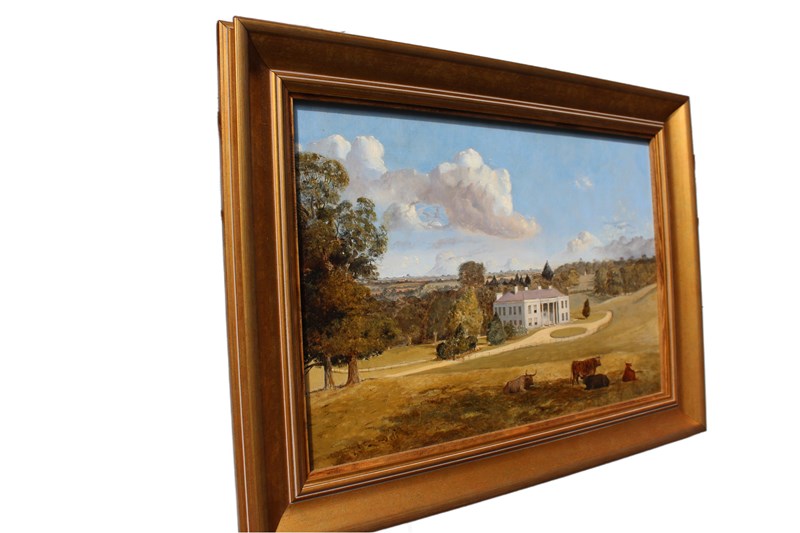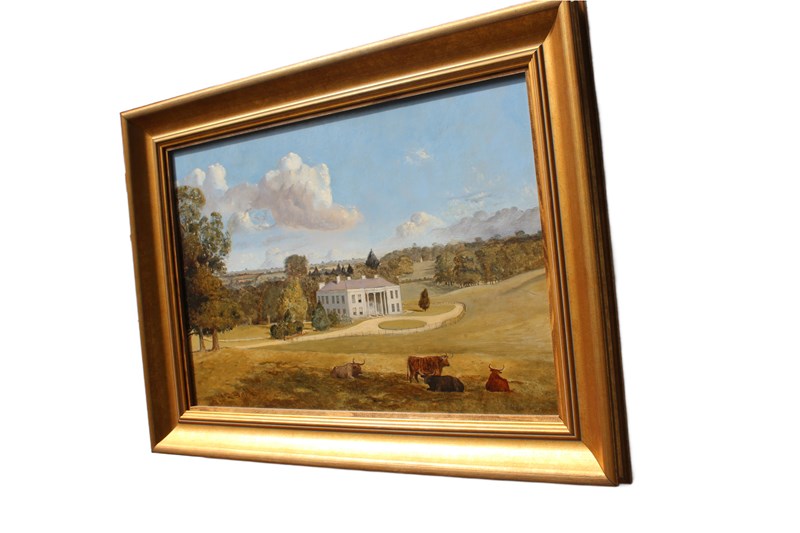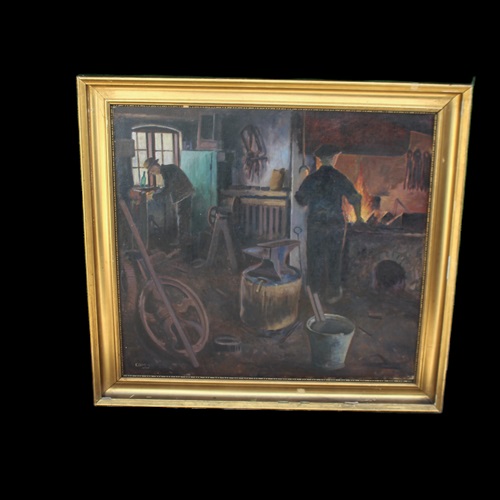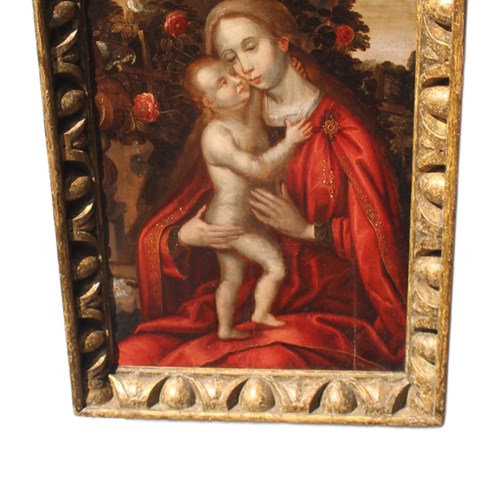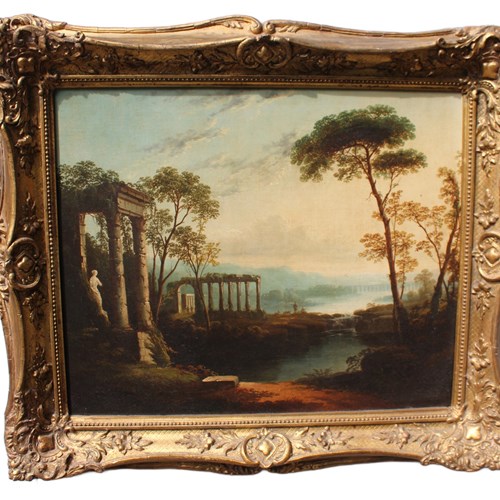19Th Century Painting Of Warlies House Essex
Stock No
VM135
2024
- £2,100.00
- €2,448 Euro
- $2,678 US Dollar
Questions about this item?
Like this item?
Item Description
19th-century painting of Warlies House Essex
This captivating mid-19th-century oil on panel painting exemplifies the idyllic charm of pastoral landscapes from the period, featuring a detailed composition that highlights both the natural beauty and rural life of Warlies Park House in Waltham Abbey, Essex. A magnificent depiction of a serene countryside scene, it showcases a harmonious balance of nature and architecture, where cows graze peacefully in the foreground, lending a sense of tranquillity and nostalgia to the work. The central focus of the painting is the historic Warlies Park House, an elegant country estate framed by gently rolling hills and expansive green fields, illustrating the grandeur of the English landscape.
The artist’s keen eye for detail is evident in the careful rendering of the estate’s neoclassical architecture, complete with white columns and symmetrical windows that reflect the architectural style of 19th-century country houses. The pastoral scene with cows in the foreground draws inspiration from Victorian rural landscapes, where cattle often symbolized prosperity and the timeless relationship between humans and nature. The use of warm earth tones in the grassy plains, contrasted with the vibrant blues and whites of the sky, creates a striking visual depth and atmospheric quality. The winding path leading to the house adds a dynamic compositional element, guiding the viewer’s gaze from the peaceful rural setting to the stately home beyond.
This historic English countryside painting embodies the artistic traditions of the Romantic and Realist movements, which celebrated the beauty of nature and rural simplicity. Paintings of this style were particularly popular in the Victorian era, reflecting the growing appreciation for the countryside as a symbol of stability and harmony during the Industrial Age. In this piece, the soft brushwork and careful attention to light and shadow evoke a calm, sunlit day, where the clouds cast gentle shadows across the estate and fields, enhancing the sense of depth and realism.
The painting also offers a significant depiction of Warlies Park Estate, an important landmark in Waltham Abbey, Essex, known for its historical and architectural value. Such artworks, often commissioned or created to commemorate noble estates, serve as important records of the period’s architectural heritage and rural environments. The country estate artwork is masterfully balanced with pastoral elements, making it an ideal representation of a time when nature and human achievement were celebrated together in art.
This piece would appeal to collectors and admirers of 19th-century English countryside painting, particularly those interested in Victorian rural scenes and historic properties. Whether as a centrepiece in a traditional room or as a refined addition to an art collection, it offers timeless charm and historical significance. Its portrayal of cattle in a rural landscape aligns with the enduring themes of prosperity and rustic life. For those seeking pastoral landscape oil paintings for sale, this work stands as a remarkable example of the genre, blending architectural elegance with bucolic serenity.
Overall, this detailed landscape painting of Warlies Park House in Waltham Abbey is a quintessential Victorian-era rural landscape, reflecting both the grandeur of English estates and the peaceful beauty of the natural world. Its combination of historic architecture, rich colour palette, and lifelike representation of livestock make it an evocative tribute to the splendour of the British landscape art tradition.
19th century painting of Warlies House Essex
Warlies Park House, located in Waltham Abbey, Essex, is a historic country house with a rich history dating back to the 18th and 19th centuries. It is renowned for its architectural elegance and its association with notable figures and events in British history. The estate, set amidst rolling parkland, represents a classic example of English rural grandeur, reflecting the tastes and lifestyles of the landed gentry during its time of prominence.
Origins and Early History
The origins of Warlies Park House can be traced to the 18th century, although the exact date of its construction remains uncertain. The house became well-known in the early 19th century when it was owned by Sir George Harrison, a prominent figure who served as a Secretary to the Treasury. His influence and affluence contributed significantly to the house’s prominence and expansion. Under his ownership, Warlies Park House became a social hub for influential political and cultural figures of the time.
Architectural Features
The house reflects the neoclassical style, characterized by symmetry, clean lines, and a restrained elegance typical of country homes of the Georgian and early Victorian periods. The exterior of Warlies Park House features classically proportioned windows and a columned entrance, evoking a sense of grandeur while maintaining a harmonious relationship with its surrounding parkland. The estate’s vast grounds, which were landscaped to complement the house, include rolling lawns, mature trees, and scenic views that frame the property.
Significant Ownership
Warlies Park House later came into the possession of Thomas Fowell Buxton, a leading abolitionist and social reformer. Buxton was instrumental in the abolition of slavery in the British Empire, working alongside figures like William Wilberforce. His residency at Warlies Park House further cemented the estate’s importance in the historical and cultural fabric of 19th-century England. The house served not only as a family residence but also as a venue for important discussions and gatherings related to the social issues of the day.
Later Uses and Preservation
In the 20th century, Warlies Park House was repurposed for various uses, reflecting changing societal needs. The estate eventually became part of the Greater London Council’s ownership and was used for administrative purposes. Despite its adaptation to modern roles, the house has retained much of its architectural charm and historical significance. Today, it stands as a testament to England’s rich heritage of country houses and their evolving roles through time.
Cultural and Artistic Significance
Warlies Park House and its surrounding landscape have inspired various artistic representations. Paintings depicting the pastoral beauty of its grounds, with cows grazing and rolling hills, capture the essence of the 19th-century rural English countryside. These artworks, often featuring the estate prominently, provide a visual record of the property’s historical appearance and its integration with the natural environment.
Conclusion
Warlies Park House in Waltham Abbey, Essex, embodies centuries of history, architectural beauty, and cultural importance. From its association with political figures to its portrayal in traditional pastoral landscape art, it remains a symbol of the enduring allure of English country estates. Its legacy continues to be celebrated as part of Britain’s architectural and artistic heritage.
FREE UK DELIVERY
Item Info
Seller
Seller Location
Seaford, Sussex
Item Dimensions
H: 59cm W: 43cm
Period
1860
Item Location
United Kingdom
Seller Location
Seaford, Sussex
Item Location
United Kingdom
Seller Contact No
+44 (0)776 1984805
+44 (0)7565 761917
More from VINTAGE MIDCENTURY


